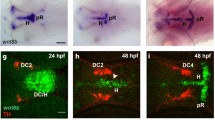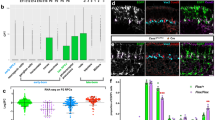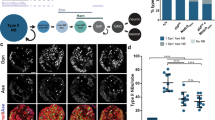Abstract
Neural progenitor cells in the developing neocortex change over time to produce different neurons, a phenomenon that is also observed in other regions of the nervous system. Mouse Numb (also known as m-numb) and Numbl (also known as numblike or Nbl) are redundant but essential in maintaining virtually all progenitor cells during early neurogenesis. They do this by allowing cells to choose progenitor over neuronal fates. To determine whether their roles change as neurogenesis progresses, we conditionally ablated both genes in the embryonic dorsal forebrain after initial waves of neurogenesis. Here we report that these proteins continue to be required for progenitor-cell maintenance, contrary to recently reported findings. As occurs during early neurogenesis, the loss of Numb and Numbl causes premature progenitor-cell depletion and, consequently, a highly specific malformation of the neocortex and hippocampus. Because progenitor cells can proliferate without Numb and Numbl before neurogenesis, we propose that Numb-mediated asymmetric cell divisions, which diversify many cell fates in Drosophila melanogaster, represent a general mechanism in mammals for stem cells to balance self-renewal and differentiation.
This is a preview of subscription content, access via your institution
Access options
Subscribe to this journal
Receive 12 print issues and online access
$209.00 per year
only $17.42 per issue
Buy this article
- Purchase on Springer Link
- Instant access to full article PDF
Prices may be subject to local taxes which are calculated during checkout







Similar content being viewed by others
References
Rakic, P. Specification of cerebral cortical areas. Science 241, 170–176 (1988).
McConnell, S.K. Constructing the cerebral cortex: neurogenesis and fate determination. Neuron 15, 761–768 (1995).
Chenn, A. & McConnell, S.K. Cleavage orientation and the asymmetric inheritance of Notch1 immunoreactivity in mammalian neurogenesis. Cell 82, 631–641 (1995).
Noctor, S.C., Martinez-Cerdeno, V., Ivic, L., Kriegstein, A.R. Cortical neurons arise in symmetric and asymmetric division zones and migrate through specific phases. Nat. Neurosci. 7, 136–144 (2004).
Caviness, V.S. Jr., Takahashi, T. & Nowakowski, R.S. Numbers, time and neocortical neurogenesis: a general developmental and evolutionary model. Trends Neurosci. 18, 379–383 (1995).
Edlund, T. & Jessell, T.M. Progression from extrinsic to intrinsic signaling in cell fate specification: a view from the nervous system. Cell 96, 211–224 (1999).
Zhong, W. Diversifying neural cells through order of birth and asymmetry of division. Neuron 37, 11–14 (2003).
Anderson, D.A. Stem cells and pattern formation in the nervous system: the possible versus the actual. Neuron 30, 19–35 (2001).
Temple, S. The development of neural stem cells. Nature 414, 112–117 (2001).
Johe, K.K., Hazel, T.G., Muller, T., Dugich-Djordjevic, M.M. & McKay, R.D.G. Single factors direct the differentiation of stem cells from the fetal and adult central nervous system. Genes Dev. 10, 3129–3140 (1996).
Shah, N.M., Groves, A. & Anderson, D.J. Alternative neural crest cell fates are instructively promoted by TGFβ superfamily members. Cell 85, 331–343 (1996).
Hitoshi, S. et al. Notch pathway molecules are essential for the maintenance, but not the generation, of mammalian neural stem cells. Genes Dev. 16, 846–858 (2002).
Machon, O., van den Bout, C.J., Backman, M., Kemler, R. & Krauss, S. Role of β-Catenin in the developing cortical and hippocampal neuroepithelium. Neuroscience 122, 129–143 (2003).
Qian, X., Goderie, S.K., Shen, Q., Stern, J.H. & Temple, S. Intrinsic programs of patterned cell lineages in isolated vertebrate CNS ventricular zone cells. Development 125, 3143–3152 (1998).
Zhong, W., Feder, J.N., Jiang, M-M., Jan, L.Y. & Jan, Y.N. Asymmetric localization of a mammalian numb homolog during mouse cortical neurogenesis. Neuron 17, 43–53 (1996).
Zhong, W., Jiang, M-M., Weinmaster, G., Jan, L.Y. & Jan, Y.N. Differential expression of mammalian Numb, Numblike and Notch1 suggests distinct roles during mouse cortical neurogenesis. Development 124, 1887–1897 (1997).
Verdi, J.M. et al. Mammalian NUMB is an evolutionarily conserved signaling adapter protein that specifies cell fate. Curr. Biol. 6, 113–145 (1996).
Rhyu, M.S., Jan, L.Y. & Jan, Y.N. Asymmetric distribution of numb protein during division of the sensory organ precursor cell confers distinct fates to daughter cells. Cell 76, 477–491 (1994).
Petersen, P.H., Zou, K., Hwang, J.K., Jan, Y.N. & Zhong, W. Progenitor cell maintenance requires numb and numblike during mouse neurogenesis. Nature 419, 929–934 (2002).
Shen, Q., Zhong, W., Jan, Y.N. & Temple, S. Asymmetric Numb distribution is critical for asymmetric cell division of mouse cerebral cortical stem cells and neuroblasts. Development 129, 4843–4853 (2002).
Verdi, J.M. et al. Distinct human NUMB isoforms regulate differentiation vs. proliferation in the neuronal lineage. Proc. Natl. Acad. Sci. USA 96, 10472–10476 (1999).
Spana, E.P. & Doe, C.Q. Numb antagonizes Notch signaling to specify sibling neuron cell fates. Neuron 17, 21–26 (1996).
Lear, B.C., Skeath, J.B. & Patel, N.H. Neural cell fate in rac1 and cycA mutants: the roles of intrinsic and extrinsic factors in asymmetric division in the Drosophila central nervous system. Mech. Dev. 88, 207–219 (1999).
Wakamatsu, Y., Maynard, T.M., Jones, S.U. & Weston, J.A. NUMB localizes in the basal cortex of mitotic avian neuroepithelial cells and modulates neuronal differentiation by binding to NOTCH-1. Neuron 23, 71–81 (1999).
Zilian, O. et al. Multiple roles of mouse numb in tuning developmental cell fates. Curr. Biol. 11, 494–501 (2001).
Gu, M., Marth, J.D., Orban, P.C., Mossmann, H. & Rajewsky, K. Deletion of a DNA polymerase β gene segment in T cells using cell type-specific gene targeting. Science 265, 103–106 (1994).
Zhong, W. et al. Mouse numb is an essential gene involved in cortical neurogenesis. Proc. Natl. Acad. Sci. USA 97, 6844–6849 (2000).
Ohtsuka, T. et al. Hes1 and Hes5 as Notch effectors in mammalian neuronal differentiation. EMBO 18, 2196–2207 (1999).
Walther, C. & Gruss, P. Pax-6, a murine paired box gene, is expressed in the developing CNS. Development 113, 1435–1449 (1991).
van den Bout, C.J., Machon, O., Rosok, O., Backman, M. & Krauss, S. The mouse enhancer element D6 directs Cre recombinase activity in the neocortex and the hippocampus. Mech. Dev. 110, 179–182 (2002).
Machon, O. et al. Forebrain-specific promoter/enhancer D6 derived from the mouse Dach1 gene controls expression in neural stem cells. Neuroscience 112, 951–966 (2002).
Marin, O. & Rubenstein, J.L. Cell migration in the forebrain. Annu. Rev. Neurosci. 26, 441–483 (2003).
Fode, C. et al. A role for neural determination genes in specifying the dorsoventral identity of telencephalic neurons. Genes Dev. 14, 67–80 (2000).
Sakakibara S. et al. Mouse-Musashi-1, a neural RNA-binding protein highly enriched in the mammalian CNS stem cell. Dev. Biol. 176, 230–242 (1996).
Furukawa, T., Mukherjee, S., Bao, Z.Z., Morrow, E.M. & Cepko, C.L. rax, Hes1, and Notch1 promote the formation of Muller glia by postnatal retinal progenitor cells. Neuron 26, 383–394 (2000).
Morrison, S.J. et al. Transient Notch activation initiates an irreversible switch from neurogenesis to gliogenesis by neural crest stem cells. Cell 101, 499–510 (2000).
Meyers, E.N., Lewandoski, M. & Martin, G.R. An Fgf8 mutant allelic series generated by Cre- and Flp-mediated recombination. Nat. Genet. 18, 136–141 (1998).
Frantz, G.D., Bohner, A.P., Akers, R.M. & McConnell, S.K. Regulation of the POU domain gene SCIP during cerebral cortical development. J. Neurosci. 14, 472–485 (1994).
McEvilly, R.J., de Diaz, M.O., Schonemann, M.D., Hooshmand, F. & Rosenfeld, M.G. Transcriptional regulation of cortical neuron migration by POU domain factors. Science 295, 1528–1532 (2002).
Sugitani, Y. et al. Brn-1 and Brn-2 share crucial roles in the production and positioning of mouse neocortical neurons. Genes Dev. 16, 1760–1765 (2002).
Yao, J. et al. Combinatorial expression patterns of individual TLE proteins during cell determination and differentiation suggest non-redundant functions for mammalian homologs of Drosophila Groucho. Dev. Growth Differ. 40, 133–146 (1998).
Anderson, S.A., Eisenstat, D.D., Shi, L. & Rubenstein, J.L. Interneuron migration from basal forebrain to neocortex: dependence on Dlx genes. Science 278, 474–476 (1997).
Salcini, A.E. et al. Binding specificity and in vivo targets of the EH domain, a novel protein-protein interaction module. Genes Dev. 11, 2239–2249 (1997).
Cayouette, M. & Raff, M. Asymmetric segregation of Numb: a mechanism for neural specification from Drosophila to mammals. Nat. Neurosci. 5, 1265–1269 (2002).
Li, H-S. et al. Inactivation of Numb and Numblike in embryonic dorsal forebrain impairs neurogenesis and disrupts cortical morphogenesis. Neuron 40, 1105–1118 (2003).
Guo, M., Jan, L.Y. & Jan, Y.N. Control of daughter cell fates during asymmetric division: interaction of Numb and Notch. Neuron 17, 27–41 (1996).
Cayouette, M. & Raff, M. The orientation of cell division influences cell-fate choice in the developing mammalian retina. Development 130, 2329–2339 (2003).
Artavanis-Tsakonas, S. Notch signaling: Cell fate control and signal integration in development. Science 284, 770–776 (1999).
Acknowledgements
We thank members of the Zhong lab for discussions, L. Nicholson for comments, S. Stifani and H. Okano for TLE4 and Musashi-1 antibodies and D. Anderson for Ngn2 cDNA. This work was supported by grants from the March of Dimes Birth Defect Foundation and the National Institutes of Health (National Institute of Neurological Disorders and Stroke) to W.Z.
Author information
Authors and Affiliations
Corresponding author
Ethics declarations
Competing interests
The authors declare no competing financial interests.
Supplementary information
Supplementary Fig. 1
Targeted disruption of mouse Nbl gene. (a) Schematic drawings of the targeting vector and the wild-type (wt or +) and the knockout (ko or −) alleles of Nbl. Exons 4 to 11 encode amino acids 37 to 603 of Nbl. LacZ encodes E. coli β-gal, which is fused in-frame with amino acid 58 of Nbl, and Neo is the neomycin-resistance gene driven by a Pgk promoter. Arrows indicate the direction of transcription. Genomic fragments and ES cells are from 129/sv mice. TAG is the Nbl stop codon. All EcoRI (E) and BamHI (B) sites are shown whereas only relevant ClaI (C), EcoRV (R) and HindIII (H) sites are shown. (b) Southern blot analysis of DNA from adult mice derived from Nbl heterozygous parents. DNA samples were digested with EcoRV and ClaI (5' end) and HindIII (3' end), respectively. The probes used are as indicated (bars in a). (c) T2 RNase protection assay of mRNA isolated from adult brain using a probe corresponding to the Nbl mRNA sequences encoded by exons 4 to 6. Yeast tRNA and Numb (m-Nb) were used as controls. (PDF 677 kb)
Supplementary Fig. 2
Cell-cycle progression and cell death in D6-cDKO mutants. (a-c) BrdU (in green) incorporation after a 30-min pulse in E14.5 D6-cDKO (b) and control (a) littermates. PI. Quantitative analysis (c) shows the percentage of BrdU-labeled cells among the cells within the ventricular zone (VZ; bracket). (d-f) Mitotic cells (phospho-Histone H3 postive, in green) in E14.7 D6-cDKO (e) and control (d) littermates given a single pulse of BrdU (in red) 5 h earlier. Quantitative analysis (f) shows the percentage of M-phase cells at the ventricular surface that are also positive for BrdU. (g-i) Programmed cell death (TUNEL staining, in green) in E15.5 D6-cDKO (f) and control (e) littermates. Quantitative analysis (i) shows the number of TUNEL-positive cells per dorsal forebrain section. Error bars show s.d. (PDF 4134 kb)
Supplementary Table 1
Summary of loss- and gain-of-function studies regarding vertebrate Numb homologs. (PDF 368 kb)
Rights and permissions
About this article
Cite this article
Petersen, P., Zou, K., Krauss, S. et al. Continuing role for mouse Numb and Numbl in maintaining progenitor cells during cortical neurogenesis. Nat Neurosci 7, 803–811 (2004). https://doi.org/10.1038/nn1289
Received:
Accepted:
Published:
Issue Date:
DOI: https://doi.org/10.1038/nn1289
This article is cited by
-
NUMB maintains bone mass by promoting degradation of PTEN and GLI1 via ubiquitination in osteoblasts
Bone Research (2018)
-
KIF20A/MKLP2 regulates the division modes of neural progenitor cells during cortical development
Nature Communications (2018)
-
Decreased Anxiety-Related Behaviour but Apparently Unperturbed NUMB Function in Ligand of NUMB Protein-X (LNX) 1/2 Double Knockout Mice
Molecular Neurobiology (2017)
-
Phenotypic and genetic characterization of a patient with a de novo interstitial 14q24.1q24.3 deletion
Molecular Cytogenetics (2014)
-
Numb-dependent integration of pre-TCR and p53 function in T-cell precursor development
Cell Death & Disease (2014)



